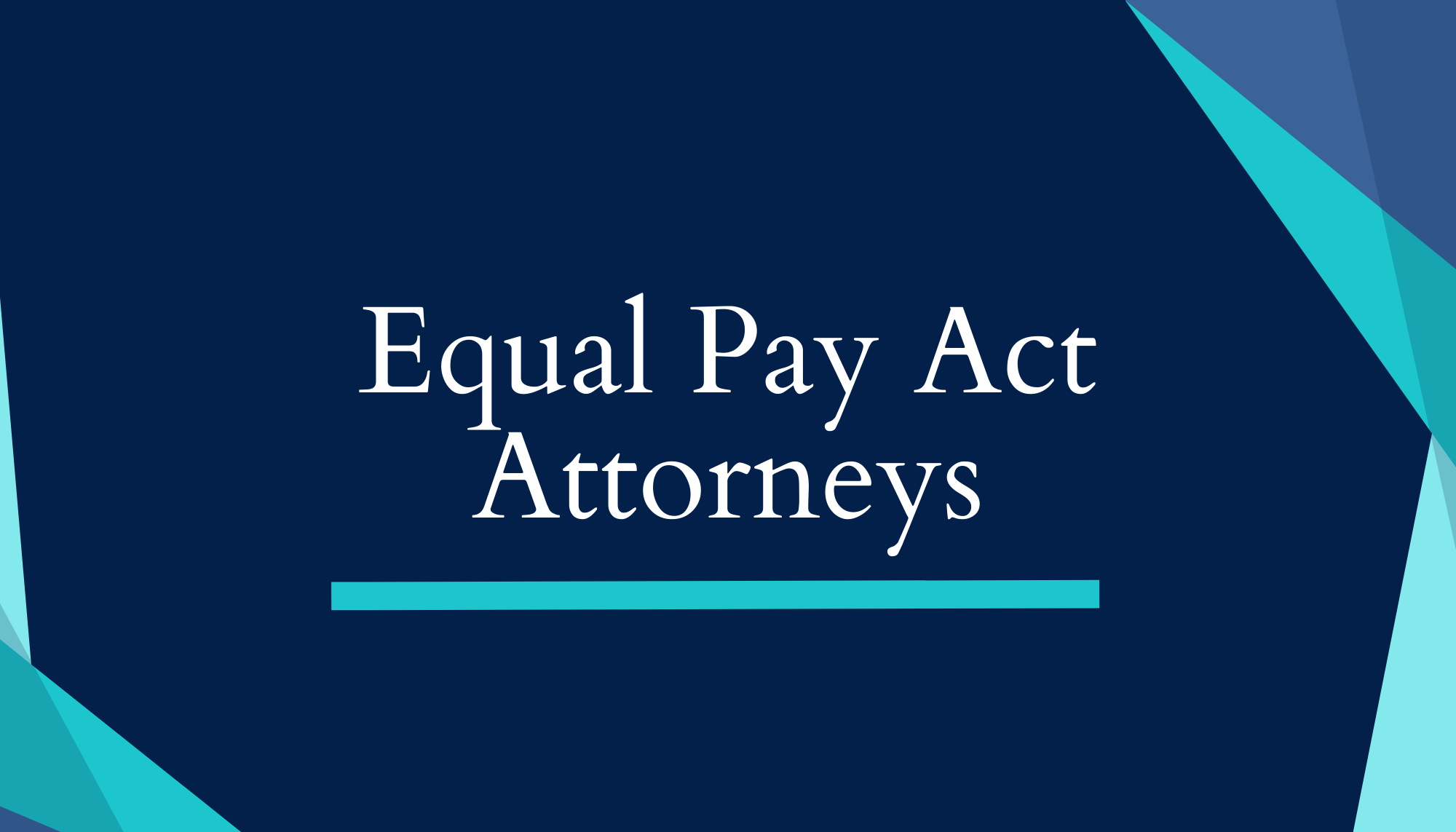Equal Pay Act
The Equal Pay Act is a federal law that prohibits wage discrimination based on general. Pay inequity based on general remains a significant issue in the U.S.

Award Winning Equal Pay Act Attorneys




Schedule A Consultation
According to Bureau of Labor Statistics data, in 2020, women earned 82 cents for every dollar men made. The gender pay gap is even wider for mothers and women of color. Equal Pay Day—the day representing the number of extra days the average woman must work to earn what the average man earned the year before—is March 24. For mothers and women of color, Equal Pay Day falls even further into the year. For Mothers, it’s June 4 (compared with fathers, on average). For Black women, it’s August 3. For Native American women, it’s September 8. Finally, for Latinas, Equal Pay Day is more than nine months into the year on October 21.
Simply put, America has a long way to go before we close the gender pay gap. The primary Federal statute designed to address the gender pay gap is the Equal Pay Act of 1963. In 1973, women only made 57 cents for every dollar earned by men. Progress is being made slowly but surely, in large part because brave women are holding their employers accountable and ensuring that they receive equal pay for equal work.
Are you performing the same job for less pay than your male colleague? Cantrell Schuette, P.A. can assist you. To speak with one of our attorneys about your Equal Pay Act case, contact us at (877) 858-6868 or coordinator@caklegal.com.
WHY HIRE CANTRELL SCHUETTE, P.A.
Victims of gender pay discrimination should hire an attorney who specializes in defending women’s rights. At Premier Litigators, we specialize in this area and are leaders in the field. For example:
- Some of our attorneys publish articles and educational materials on matters of women’s rights and regularly provide training seminars to other professionals on the subject, including training HR, business owners, and even other attorneys.
- The attorneys at Cantrell Schuette, P.A. are award-winning. Most have an “AV” rating by Martindale Hubbel (a peer-reviewed rating), honored by Super Lawyers (a peer-reviewed rating), and achieved “Best Lawyers” status by Best Lawyers (a peer-reviewed rating).
- Our attorneys have real and substantial experience. Collectively, our attorneys have represented hundreds of plaintiff-side clients with gender discrimination claims. All our other attorneys also have significant trial and arbitration experience. We are regularly referred clients for employment law matters by other attorneys.
We do not rest on our credentials. Our attorneys engage in educational panels to stay abreast of employment law, legal developments (including gender pay discrimination), and cutting-edge practices every month. In short, Cantrell Schuette consists of highly skilled employment law attorneys who have dedicated their careers to help ensure gender equality in the workplace.
To speak with one of our attorneys about your Equal Pay Act case, contact us at (877) 858-6868 or coordinator@caklegal.com.


EQUAL PAY DISPUTES WE HANDLE
Cantrell Schuette represent clients in employment law matters, focusing on plaintiffs. We handle gender pay discrimination claims under the following State and Federal Statutes:
- The Equal Pay Act of 1963
- California’s Equal Pay Act
- Florida’s Wage Rate Discrimination Law
- Illinois’ Equal Pay Act
- Michigan’s Workplace Opportunity Wage Act
In addition to Equal Pay Act claims, our employment law practice also includes, among others:
- Discrimination, Harassment, and Retaliation
- Non-Competes
- Breach of Contract
- Employment Law Counseling
- Bonuses and Commissions
- Wage and Hour
- Sexual Harrassment
- Hostile Work Environment
- Whistleblowers
EXAMPLES OF CASES WE’VE HANDLED
Here are representative examples of just a few of our more prominent gender discrimination cases:
- Successfully obtained a mid-six-figure settlement in a single-plaintiff sexual harassment and retaliation case where the female employee was shown graphic pictures by a male co-worker and was forced to resign by her employer after she complained to management.
- Successfully obtained a mid-six-figure settlement in a single-plaintiff disability and gender discrimination, harassment, and retaliation case against a hospital where an employee was terminated because she missed too many days while receiving cancer treatment.
- Successful won trial Miami, Florida in case involving claims of sex and pregnancy discrimination.
To speak with one of our attorneys about your Equal Pay Act case, contact us at (877) 858-6868 or coordinator@caklegal.com.
FREQUENTLY ASKED QUESTIONS
At its core, the Equal Pay Act ensures “equal pay for equal work.” Specifically, the Equal Pay Act of 1963 (“EPA”) , 29 U.S.C. §§206 et seq., states:
No employer having employees subject to any provisions of this section shall discriminate, within any establishment in which such employees are employed, between employees on the basis of sex by paying wages to employees in such establishment at a rate less than the rate at which he pays wages to employees of the opposite sex in such establishment for equal work on jobs the performance of which requires equal skill, effort, and responsibility, and which are performed under similar working conditions.
The EEOC offers two examples of EPA violations:
- [W]here an employee of one sex is hired or assigned to a particular job to replace an employee of the opposite sex but receives a lower rate of pay than the person replaced, a prima facie violation of the EPA exists.
- If a person of one sex succeeds a person of the opposite sex on a job at a higher rate of pay than the predecessor, and there is no reason for the higher rate other than difference in gender, a violation as to the predecessor is established and that person is entitled to recover the difference between his or her pay and the higher rate paid the successor employee.
Although the EPA does not define the term “wages,” the EEOC defines the term “wages” extraordinarily broadly. The EEOC defines “wages” as “all forms of compensation irrespective of the time of payment, whether paid periodically or deferred until a later date” This includes:
- Wages
- Salary
- Holiday pay
- Vacation pay
- Premium pay for weekends
- Profit sharing
- Expense accounts
- Bonuses
- Uniform cleaning allowances
- Hotel accommodations
- Use of a company car
- Gas allowances
The equal work standard does “not require that compared jobs be identical, only that they be substantially equal.” 29 C.F.R. §1620.13(a). Both the courts and the EEOC have routinely held that “[i]nsubstantial or minor differences in the degree or amount of skill, or effort, or responsibility required for the performance of jobs will not render the equal pay standard inapplicable.” 29 C.F.R. §1620.14(a) ; Nyman v. F.D.I.C., 967 F. Supp. 1562, 1577 (D.DC. 1997) (“Positions can therefore be substantially equal even if there are insubstantial or minor differences in the degree or amount of skill, effort or responsibility required for the performance of the job.”)
When assessing whether the jobs are “substantially equivalent,” the actual work performed, not the formal job descriptions, controls. 29 C.F.R. §1620.13(e) (“Job content controlling. Application of the equal pay standard is not dependent on job classifications or titles but depends rather on actual job requirements and performance.”); Horn v. University of Minnesota, 2004 WL 726096 (8th Cir. 2004) (“Whether two jobs are substantially equal requires a practical judgment on the basis of all the facts and circumstances of a particular case, including factors such as level of experience, training, education, ability, effort, and responsibility. Application of the Equal Pay Act depends not on job titles or classifications but the actual requirements and performance of the job. In all cases, therefore, a court must compare the jobs in question in light of the full factual situation and the broad remedial purpose of the statute.”).
When determining whether employees are performing equal work, a number of factors must be examined, including the amount of time the employees spend in the performance of different duties. 29 C.F.R. §1620.14(c). Additionally, courts consider whether the jobs:
- Require equal skill;
- Require equal effort
- Require equal responsibility; and
- Are performed under similar working conditions.
To determine whether the jobs require “equal skill,” courts examine whether the experience, ability, education, and training required are substantially the same for each job. Forsberg v. Pacific Northwest Bell Telephone Co., 840 F.2d 1409, 1415 (9th Cir. 1988)
To determine whether the jobs require “equal effort,” courts have stated:
[J]obs do not entail equal effort, even though they entail most of the same routine duties, if the more highly paid job involves additional tasks which (1) require extra effort, (2) consume a significant amount of the time of all those whose pay differentials are to be justified in terms of them, and (3) are of an economic value commensurate with the pay differential.
Employers may not be permitted to frustrate the purposes of the Act by calling for extra effort only occasionally, or only from one or two male employees, or by paying males substantially more than females for the performance of tasks which command a low rate of pay when performed full time by other personnel in the same establishment.
Hodgson v. Brookhaven General Hospital, 436 F.2d 719, 725 (5th Cir. 1970).
To determine whether the jobs require “equal responsibility,” courts examine “the degree of accountability required in the performance of the job, with emphasis on the importance of the job obligation.” 29 C.F.R. §1620.17.
The leading case examining “similar working conditions” is a US Supreme Court case. Corning Glass Works v. Brennan, 417 U.S. 188, 94 S.Ct. 2223 (1974). The Supreme Court confronted the question: Does a night shift supervisor perform work under “similar working conditions” as a day shift supervisor. The Supreme Court held that work on the night and day shifts was performed under “similar working conditions.” The Court explained that “working conditions” has two subfactors, surroundings and hazards:
‘Surroundings’ measures the elements, such as toxic chemicals or fumes, regularly encountered by a worker, their intensity, and their frequency. ‘Hazards’ takes into account the physical hazards regularly encountered, their frequency, and the severity of injury they can cause.
417 U.S. at 202, 94 S.Ct. at 2232.
“The Equal Pay Act creates a type of strict liability; no intent to discriminate need be shown.” Maxwell v. City of Tucson, 803 F.2d 444, 446 (9th Cir. 1986). To prove a prima facie case, the plaintiff must show only that he or she is receiving different wages for equal work—not that their employer intended to pay men and women differently for equal work.
EPA claims only have two steps (as opposed to the three step process found in typical employment discrimination cases): (1) plaintiff has the burden of establishing a prima facie case showing sex-based wage differential; and (2) the burden then shifts to the employer to show an affirmative defense. No showing of pretext is required.
To win an EPA claim, plaintiff must prove that an actual employee of the opposite sex performed substantially similar work for a higher wage. Plaintiff cannot compare herself to a hypothetical employee. Houck v. Virginia Polytechnic Institute, 10 F.3d 204, 206-07 (4th Cir. 1993) (“The plaintiff may not compare herself to a hypothetical male with a composite average of a group’s skill, effort, and responsibility, but must identify a particular male for the inquiry.”)
Additionally, plaintiff must show that she was paid less than another employee of the opposite sex working at the same establishment. While the EPA does not define “establishment,” the EEOC does as follows:
(a) Although not expressly defined in the FLSA, the term ‘establishment’ had acquired a well settled meaning by the time of enactment of the Equal Pay Act. It refers to a distinct physical place of business rather than to an entire business or ‘enterprise” which may include several separate places of business. Accordingly, each physically separate place of business is ordinarily considered a separate establishment.
(b) In unusual circumstances, two or more portions of a business enterprise, even though located in a single physical place of business, may constitute more than one establishment. For example, the facts might reveal that these portions of the enterprise are physically segregated, engaged in functionally separate operations, and have separate employees and maintain separate records. Conversely, unusual circumstances may call for two or more distinct physical portions of a business enterprise being treated as a single establishment. For example, a central administrative unit may hire all employees, set wages, and assign the location of employment; employees may frequently interchange work locations; and daily duties may be virtually identical and performed under similar working conditions. Barring unusual circumstances, however, the term “establishment” will be applied as described in paragraph (a) of this section.
Generally, courts define the term “establishment” more broadly than the EEOC. See Mulhall v. Advance Sec., 19 F.3d 586 (11th Cir. 1994) (“The term ‘establishment’ is defined by the Secretary of Labor as ‘a distinct physical place of business rather than … an entire business or ‘enterprise’ which may include several separate places of business.’ Nonetheless, the former Fifth Circuit recognized in [Brennan v. Goose Creek Consolidated Indep. Sch. Dist., 519 F.2d 53, 57 (5th Cir. 1975)] that there are situations in which a single establishment can include operations at more than one physical location. A contrary result obtained through narrow construction of the word ‘establishment’ could ‘make proof of discrimination more difficult, thus frustrating congressional intent.’ Goose Creek set a widely followed standard recognizing that central control and administration of disparate job sites can support a finding of a single establishment for purposes of the EPA. The hallmarks of this standard are centralized control of job descriptions, salary administration, and job assignments or functions.”) (citations and footnote omitted); Smith v. Allstate Ins. Corp., 24 F. Supp. 2d 870, 879 (N.D. Ill. 1998) (“Although ‘establishment’ is defined by the Secretary of Labor as ‘a distinct physical place of business rather than … an entire business or ‘enterprise’ which may include several separate places of business,’ there are situations where a single establishment can include operations at more than one physical location. ‘[C]entral control and administration of disparate job sites can support a finding of a single establishment for purposes of the EPA. The hallmarks of this standard are centralized control of job descriptions, salary administration, and job assignments or functions.’”) (citations omitted).
No. The EPA prohibits employers from retaliating against employees who complain about EPA violations or testify in a proceeding involving an alleged EPA violation.
It shall be unlawful for any person … to discharge or in any other manner discriminate against any employee because such employee has filed any complaint or instituted or caused to be instituted any proceeding under or related to this chapter, or has testified or is about to testify in any such proceeding, or has served or is about to serve on an industry committee.
As is often the case, California has its own version of Federal law that is even more generous to employees. In addition to ensuring equal pay for equal work between men and women, California’s Equal Pay Act also ensure equal pay for equal work for people of different races and ethnicities. For example, if an African-American an Caucasian employee perform equal work, but the Caucasian employee is paid more, this would violate California’s Equal Pay Act.
California’s Equal Pay Act provides broader protection than the Federal Equal Pay Act in several ways. California’s Equal Pay Act:
- Requires equal pay for employees who perform “substantially similar work”—as opposed to the more difficult to prove “equal work” under Federal law;
- Eliminates the requirement under Federal law that the employees being compared work at the “same establishment”;
- Elevates an employers burden to satisfy the “bona fide factor other than sex” defense;
- Ensures that any legitimate factors—factors other than sex, race, or ethnicity—relied upon by the employer to explain the differencce pay account for the entire pay difference;
- Makes it illegal for employers to prohibit employees from discussing or inquiring about their co-workers’ wages; and
- Extends the number of years that employers must maintain wage and other employment-related records (recordkeeping) from two years to three years.
In short, if you are a California Employee bringing an Equal Pay Act claim, you should almost always include a claim under California’s Equal Pay Act.
The EPA provides for the following damages:
- The amount that plaintiff was underpaid (difference between wages for equal work);
- Liquidated damages in the same amount the plaintiff was underpaid;
- Attorneys’ fees and costs.
For example, if two employees are doing “equal work,” but Employee A (a female) is paid $40,000/year, and Employee B (a male) is paid $50,000/year. In this example, Employee A would be entitled to $10,000 for the preceding two years (or three years if plaintiff can prove the pay discrepancy was “willful”), so $20,000 (or $30,000 if the violation was “willful”).
Employee A would also be entitled to an equal amount in “liquidated damages.” In this example, Employee A would be entitled to an additional $20,000 (or $30,000 if the violation was “willful”) for a total of $40,000. However, a court may decline to award “liquidated damages” if it determines the employer acted in “good faith.”
Finally, Employee A would be entitled to seek the reasonable attorney’s fees related to the lawsuit if she prevails.
No. The EPA strictly prohibits employers from reducing the wage rate of any employee in order to comply with the EPA. 29 U.S.C. §206(d)(1) (“A]n employer who is paying a wage differential in violation of [the Act] shall not, in order to comply with the provisions of this subsection, reduce the wage rate of any employee.”); See also, EEOC v. Romeo Community Schools, 976 F.2d 985, 988 (6th Cir. 1992) (“The Equal Pay Act expressly prohibits an employer who violates the Act from curing the violation by lowering the wages of male employees.”).
To speak with one of our attorneys about your Equal Pay Act case, contact us at (877) 858-6868 or coordinator@caklegal.com.

